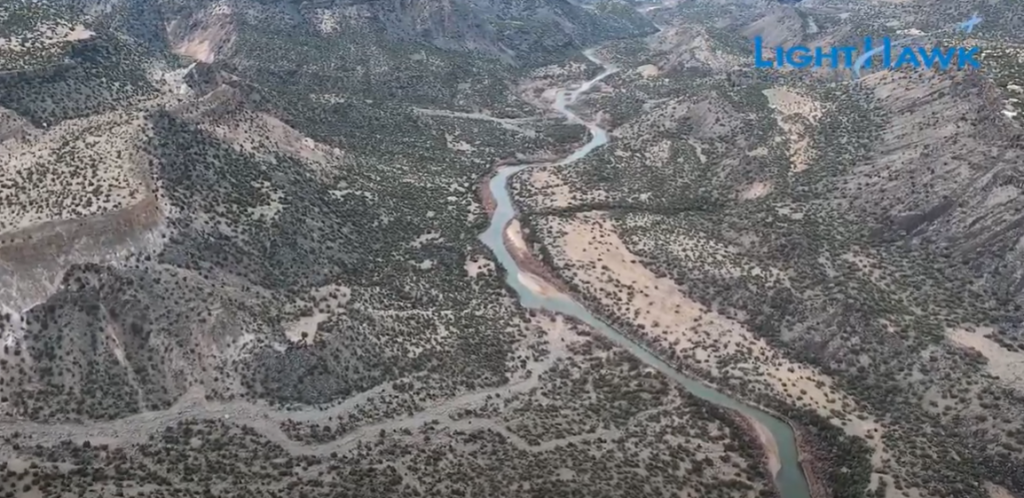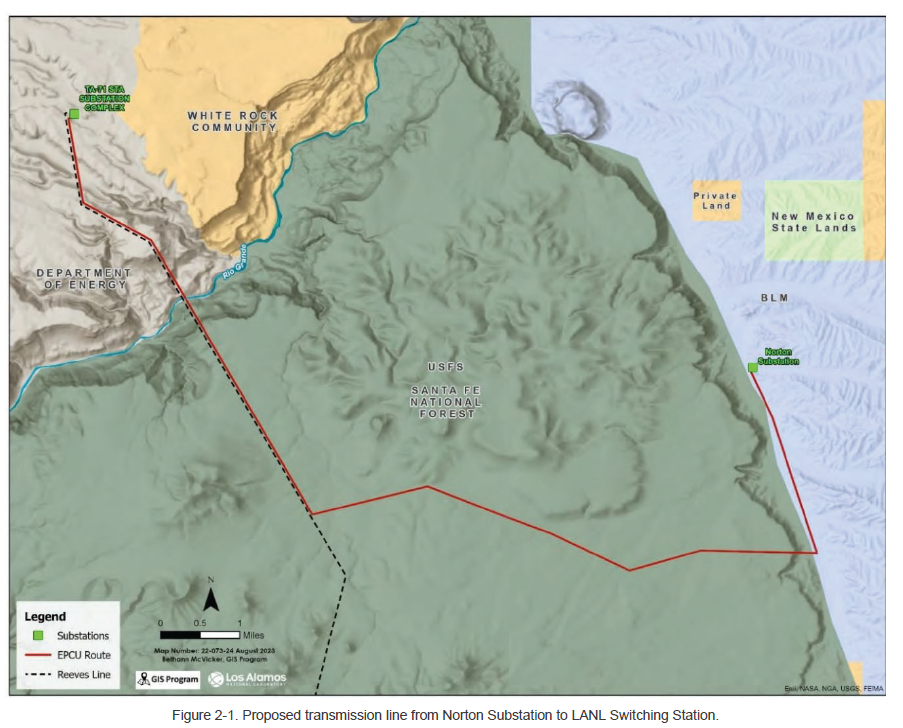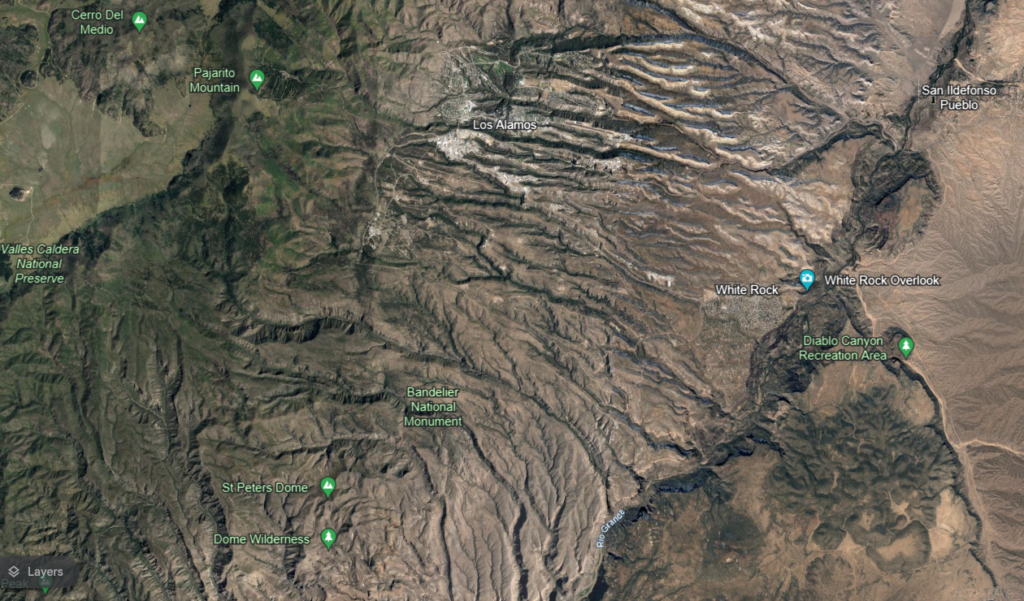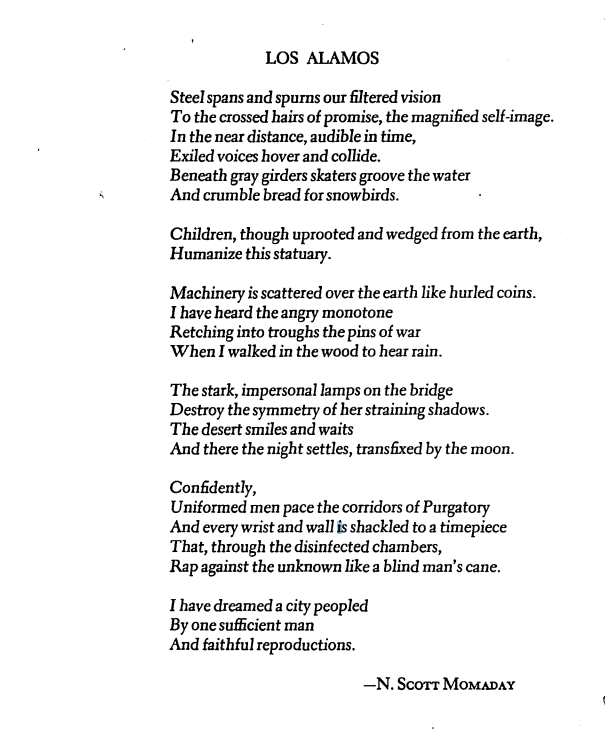‘I have heard the angry monotone’

Dear friends,
Six days before Christmas, the U.S. Department of Energy and its National Nuclear Security Administration opened public comment on a proposed 115 kilovolt powerline for Los Alamos National Laboratory.
According to the NNSA, the nuclear weapons lab needs the new, 14-mile-long powerline to increase capacity and “support mission programs”—including the expanded production of parts for nuclear weapons. (You’ve heard a lot about “plutonium pit production.” Plutonium pits are the bowling ball-sized hollow spheres that trigger nuclear explosives inside a warhead or bomb.)
If built, the new transmission line will need a new, 100-foot-wide utility corridor on lands managed by the U.S. Forest Service and the Bureau of Land Management.
The NNSA’s draft environmental assessment includes a few maps, like the one below, of the proposed transmission line’s route from PNM’s Norton Substation (the green square on BLM land) across White Rock Canyon to LANL’s switching station (the green square on DOE land).
If you’re interested in seeing where the 70-foot-tall powerline will cross the Rio Grande, I had posted some footage on our Instagram account last month. (At the time, I was just gawking at some old footage of the river there and thinking about Cochiti Dam; but you should go look at that beautiful canyon.) Below, I’ve also included a screenshot of that general area from Google Earth, so you can see the project area and surrounding landmarks more clearly.


The newly extended public comment period is open until February 20. On the DOE website, you can find out how to comment, read the draft environmental assessment, and find information about a public meeting in Santa Fe later this week on January 11.
Speaking of nuclear weapons, Santa Fe had discussed opposing new plutonium pit production at Los Alamos, but as Evan Chandler reported for the Santa Fe Reporter last week, City of Santa Fe District 4 Councilor Jamie Cassutt pulled back on the resolution.
According to SFR’s story:
“Following petitions at several recent City Council meetings, last month District 4 Councilor Jamie Cassutt and District 1 Councilor Renee Villarreal introduced a resolution calling on the federal government to halt preparations for pit production; prioritize cleanup of legacy nuclear waste; and decrease spending for nuclear weapons.
With Villarreal no longer on the council, Cassutt remained as the sole sponsor. But facing pushback from LANL backers and a lack of buy-in from Mayor Alan Webber, she says she will stall the proposal before its first scheduled committee hearing this week.”
SFR’s Chandler quotes Cassutt saying: “Obviously, the economic development impact of LANL for our community and for Northern New Mexico is huge. I think what’s really important for me is that I am not of the mindset of ‘LANL is this awful, terrible, evil organization.’ They do a lot of wonderful work. They have a lot of employees that are wonderful members of our community, and so for me just really…having a better picture of it all is important for me before I’m able to carry legislation.”
All of this reminds me of N. Scott Momaday’s poem, “Los Alamos.” First printed in New Mexico Quarterly in 1959, the poem is in UNM’s digital depository.

Some news to mention:
• “In the Scar of New Mexico’s Largest Wildfire, a Legal Battle Is Brewing: What Is Victims’ Suffering Worth?” (Patrick Lohmann and Byard Duncan, Source New Mexico/ProPublica)
• “The New Mexico co-op breaking up with fossil fuels” (Mary Catherine O’Connor, High Country News)
• “New lawsuit alleges FEMA fails to fulfill wildfire claims within required period” (Phaedra Haywood, Santa Fe New Mexican)
• “New Mexico regulators reject utility’s effort to recoup some investments in coal and nuclear plants” (Susan Montoya Bryan, Associated Press)
• “New Mexico considers setback requirements for oil wells near schools and day care centers” (Susan Montoya Bryan, Associated Press)
• “U.S. management plan aims to protect New Mexico’s old-growth and maturing forests” (Scott Wyland, Santa Fe New Mexican)
There’s a new jaguar hanging around in southern Arizona. Or at least, a jaguar who hasn’t been identified previously.
Last week, the Center for Biological Diversity shared trail camera video from Jason Miller that shows a jaguar with a rosette pattern different from other documented jaguars in the area, like Sombra and El Jefe. And F2754, the female wolf who has twice dispersed from her pack to travel northward on her own, was captured in early December. But over the holiday, the National Park Service shared a photo of her that Bryan Ramsay snapped in the Valle Grande. According to NPS, the last documented Mexican wolf sighting in Valles Caldera was in 1932.
And if you’re still thinking about N. Scott Momaday, read this 2022 interview with him in The Paris Review. The photos are great, especially the one in San Ysidro around 1950.
Although I didn’t know him personally, I admired Klee Benally and was sad to learn that he died recently. You can read more about his life in The New York Times obituary that was published Sunday.
Lastly, just a note about the next twelve months. In the coming year on Our Land, you’ll hear a lot about climate change and other environmental and moral issues. For seven seasons at NMPBS, I’ve covered the science of climate change; the physical impacts of warming on our forests and rivers and communities; and the connection between greenhouse gas emissions and the increasing likelihood that tomorrow’s New Mexicans will face far greater challenges than we can imagine today.
I’ll keep reporting on all those issues. But this year, the show will also focus on moral questions, including adaptation within and to a changing world—and how communities learn from and lift one another in the absence of action and commitment from politicians, lawmakers, governments, industries, and businesses. As with say, nuclear weapons production, there are too few public conversations in New Mexico around climate change and specifically, around the morality of letting the world burn—while knowing how to douse the fires. Stay tuned. It’s going to be an interesting and challenging year.
P.S. If a friend forwarded you this message, sign up here to receive the newsletter yourself. You can also read recent newsletters online. And if you miss us throughout the week, follow Our Land on Instagram.


